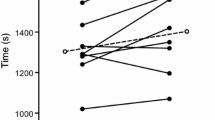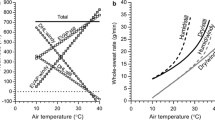Abstract
We have previously demonstrated that provision of a cold fluid (4°C) during exercise in the heat increases fluid intake and improves exercise capacity when compared to a control fluid (19°C). The present study investigated whether these positive effects could simply be replicated with a cooling agent, menthol. Nine healthy, non-acclimatised males (25 ± 7 years; \( \dot{V} \)O2max: 54 ± 5 ml kg−1 min−1) cycled to exhaustion at 65% of their peak aerobic power output at 34°C, swilling 25 ml of either an l(−)-menthol (0.01%) or orange-flavoured placebo solution every 10 min, whilst water was available ad libitum; all fluids were kept at 19°C. Eight out of nine subjects cycled for longer whilst swilling with menthol and this resulted in a 9 ± 12% improvement in endurance capacity. Rectal temperatures rose by 1.7°C during exercise with the same time course in both conditions, whilst skin temperature remained largely unchanged. Swilling with menthol resulted in hyperventilation by 8 ± 10 L min−1 and reduced central (cardiopulmonary) ratings of perceived exertion by 15 ± 14%. No differences between trials were observed for heart rate, oxygen uptake or carbon dioxide production, blood concentrations of glucose or lactate, sweat rate or volume of water ingested. We conclude that a change in the sensation of oropharyngeal temperature during exercise in the heat significantly affects endurance capacity, ventilation and the (central) sense of effort.


Similar content being viewed by others
References
Armada-da-Silva PAS, Woods J, Jones DA (2004) The effect of passive heating and face cooling on perceived exertion during exercise in the heat. Eur J Appl Physiol 91:563–571
Borg GAV (1982) Psychophysical bases of perceived exertion. Med Sci Sports Exerc 14:377–381
Carter J, Jeukendrup AE, Mündel T, Jones DA (2003) Carbohydrate supplementation improves moderate- and high-intensity exercise in the heat. Pflügers Arch 446:211–219
Chambers ES, Bridge MW, Jones DA (2009) Carbohydrate sensing in the human mouth: effects on exercise performance and brain activity. J Physiol 587:1779–1794
Dill DB, Costill DL (1974) Calculation of percentage changes in volumes of blood, plasma, and red cells in dehydration. J Appl Physiol 37:247–248
Eccles R (1994) Menthol and related cooling compounds. J Pharm Pharmacol 46:618–630
Eccles R (2000) Role of cold receptors and menthol in thirst, the drive to breathe and arousal. Appetite 34:29–35
Eccles R, Jawad MS, Morris S (1990) The effects of oral administration of (−)-menthol on nasal resistance to airflow and nasal sensation of airflow in subjects suffering from nasal congestion associated with the common cold. J Pharm Pharmacol 42:652–654
Ekblom B, Goldbarg AN (1971) The influence of physical training and other factors on the subjective rating of perceived exertion. Acta Physiol Scand 83:399–406
Fink WJ, Costill DL, Van Handel PJ (1975) Leg muscle metabolism during exercise in the heat and cold. Eur J Appl Physiol Occup Physiol 34:183–190
Galloway SD, Maughan RJ (1997) Effects of ambient temperature on the capacity to perform prolonged cycle exercise in man. Med Sci Sports Exerc 29:1240–1249
Green BG (1985) Menthol modulates oral sensations of warmth and cold. Percept Psychophys 38:110–114
Guest S, Grabenhorst F, Essick G, Chen Y, Young M, McGlone F, de Araujo I, Rolls ET (2007) Human cortical representation of oral temperature. Physiol Behav 92:975–984
Kay D, Marino FE (2000) Fluid ingestion and exercise hyperthermia: implications for performance, thermoregulation, metabolism and the development of fatigue. J Sports Sci 18:71–82
Kay D, Taaffe DR, Marino FE (1999) Whole-body pre-cooling and heat storage during self-paced cycling performance in warm humid conditions. J Sports Sci 17:937–944
Lee JK, Shirreffs SM (2007) The influence of drink temperature on thermoregulatory responses during prolonged exercise in a moderate environment. J Sports Sci 25:975–985
Lee JK, Maughan RJ, Shirreffs SM (2008a) The influence of serial feeding of drinks at different temperatures on thermoregulatory responses during cycling. J Sports Sci 26:583–590
Lee JK, Shirreffs SM, Maughan RJ (2008b) Cold drink ingestion improves exercise endurance capacity in the heat. Med Sci Sports Exerc 40:1637–1644
Marino FE (2002) Methods, advantages, and limitations of body cooling for exercise performance. Br J Sports Med 36:89–94
Mitchell JW, Nadel ER, Stolwijk JA (1972) Respiratory weight losses during exercise. J Appl Physiol 32:474–476
Mündel T, Jones DA (2006) Effect of transdermal nicotine administration on exercise endurance. Exp Physiol 91:705–713
Mündel T, King J, Collacott E, Jones DA (2006) Drink temperature influences fluid intake and endurance capacity during exercise in a hot, dry environment. Exp Physiol 91:925–933
Mündel T, Bunn SJ, Hooper PL, Jones DA (2007) The effects of face-cooling during hyperthermic exercise in man: evidence for an integrated thermal, neuroendocrine and behavioural response. Exp Physiol 92:187–195
Naito K, Ohaka E, Kato R, Kondo Y, Iwata S (1991) The effect of l-menthol stimulation of the major palatine nerve on nasal patency. Auris Nasus Larynx 18:221–226
Nielsen R, Nielsen B (1984) Measurement of mean skin temperature of clothed persons in cool environments. Eur J Appl Physiol Occup Physiol 53:231–236
Nielsen B, Hales JR, Strange S, Christensen NJ, Warberg J, Saltin B (1993) Human circulatory and thermoregulatory adaptations with heat acclimation and exercise in a hot, dry environment. J Physiol 460:467–485
Noakes TD (1993) Fluid replacement during exercise. Exerc Sport Sci Rev 21:297–330
Noble BJ, Robertson RJ (1996) Perceived exertion. Human Kinetics, Illinois
Noble BJ, Borg GA, Jacobs I, Ceci R, Kaiser P (1983) A category-ratio perceived exertion scale: relationship to blood and muscle lactates and heart rate. Med Sci Sports Exerc 15:523–528
Parkin JM, Carey MF, Zhao S, Febbraio MA (1999) Effect of ambient temperature on human skeletal muscle metabolism during fatiguing submaximal exercise. J Appl Physiol 86:902–908
Robertson RJ (1982) Central signals of perceived exertion during dynamic exercise. Med Sci Sports Exerc 14:390–396
Rowell LB, Bruce HJ, Conn RD, Kusumi F (1966) Reductions in cardiac output, central blood volume, and stroke volume with thermal stress in normal men during exercise. J Clin Invest 45:1801–1816
Sandick BL, Engell DB, Maller O (1984) Perception of drinking water temperature and effects for humans after exercise. Physiol Behav 32:851–855
Simmons SE, Mündel T, Jones DA (2008) The effects of passive heating and head-cooling on perception of exercise in the heat. Eur J Appl Physiol 104:281–288
Snellen JW (1966) Mean body temperature and the control of thermal sweating. Acta Physiol Pharmacol Neerl 14:99–174
Tatterson AJ, Hahn AG, Martin DT, Febbraio MA (2000) Effects of heat stress on physiological responses and exercise performance in elite cyclists. J Sci Med Sport 3:186–193
Watson HR, Hems R, Rowsell DG, Spring DJ (1978) New compounds with the menthol cooling effect. J Cosmet Sci 29:185–200
Acknowledgments
The authors gratefully acknowledge the subjects for their time and effort, especially after failing equipment amounted to repeat visits.
Conflict of interest statement
None.
Author information
Authors and Affiliations
Corresponding author
Rights and permissions
About this article
Cite this article
Mündel, T., Jones, D.A. The effects of swilling an l(−)-menthol solution during exercise in the heat. Eur J Appl Physiol 109, 59–65 (2010). https://doi.org/10.1007/s00421-009-1180-9
Accepted:
Published:
Issue Date:
DOI: https://doi.org/10.1007/s00421-009-1180-9




